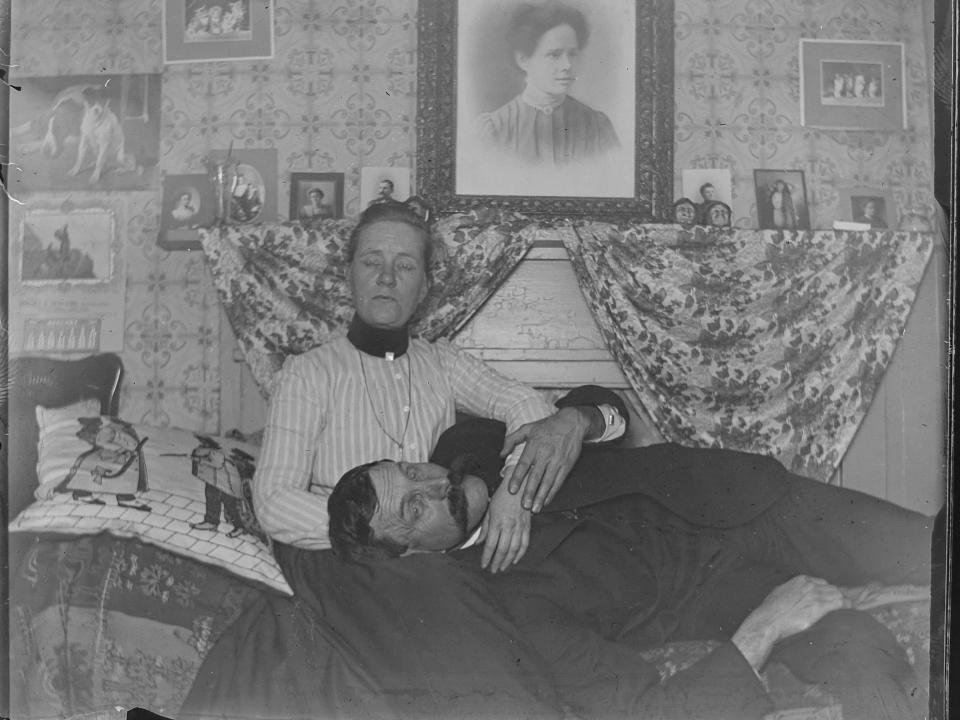Historically Speaking: Mystery photographer behind the glass-plate negatives from Exeter
Do you still have envelopes full of negatives? Now that photography is digital, there aren’t any negatives to save.
Someday, someone might come across your old files and pull up the old prom pictures, but more likely, they’ll be lost for all time. The beauty of having negatives was that images were saved and could be reproduced.
Wet-plate photography was used during the Civil War. It was an arduous process, requiring the photographer to prepare a sheet of glass with chemicals – first collodion then silver nitrate – while in a darkroom or tent. This was then clamped into a lightproof case before it was placed into the camera and exposed. After that, it needed to be developed, fixed, varnished and was finally ready to be printed out on paper. The results were usually excellent, but most photographers didn’t save the negatives. Glass plates were expensive. There are accounts of photographers selling their old negatives for use as greenhouse glass, which faded the images over time.

In 1871, dry plate photography allowed the photographer to purchase glass that was already treated and ready for use. This had the advantage of being easier in the field and not as prone to getting all the chemicals wrong. The glass was thinner and lighter, but the quality was better. Exeter had numerous photographers during these years and some wonderful photographs that depict our more noteworthy town sights.
Recently, the Exeter Historical Society was given a collection of glass-plate negatives that had been rescued by long-time member (and emeritus Trustee) Peter Smith. Boxes of plates had been stored in the Perley Gardner house on Front Street. The photographer is still unknown, but we have uncovered a lot of clues about the images.
Thanks to digitization, we no longer have to risk breaking the delicate glass by having them sent out for processing.
The plates were placed on a light board, photographed with a digital camera, and photoshopped to reverse the image. With over 200 pictures in the collection, it seemed reasonable that we’d be able to identify at least a few of the people and locations. But, alas, although many of the pictures appear to be taken in Exeter, New Hampshire, many are not. The collection is a tantalizing mixture of portraits, popular outdoor locations, and business interiors. Some are easy to figure out – there’s a series of pictures of the John Greenleaf Whittier homestead and the chain bridge in Amesbury, Massachusetts. There are a few scenes from Europe. There’s one photo that is located in downtown Ayer, Massachusetts, which we were able to identify by the signs on the buildings.
Dozens of the photos are of the interiors of businesses. It almost seems that the photographer had been hired to take the pictures for a Chamber of Commerce booklet. Zooming in on the pictures, it was easy to look at the wall calendars to determine that most were taken in January or February of 1903. The proprietors usually stand proudly in front of their wares, often with employees at the ready. Frustratingly, none of the shops have their own names on display, so it cannot be determined for certain if they are Exeter shops, unless there are advertising posters on display. One shop, which seems to sell paint, varnish, and starch, has a poster for the Exeter Improved Order of Red Men event that was coming up.
Still, even without the exact identity of the shop, the photos tell us a lot about commerce 120 years ago. Whereas today we go to a big box store for nearly everything, back then you had to be very specific about where you shopped. Stores sold items that seemed like odd pairings – like fruit, confectionary and tobacco. One photo of fruit, candy, and tobacco seems odd, but there were numerous such shops. A comparison with the town directory indicates that there were four such shops, three of which were on Front Street. The plates show billiard halls, both upscale and working class. Hardware stores, wallpaper shops, an umbrella repair shop (with a sign threatening, “goods not called for in 30 days will be sold to pay charges”). Barbershops were big business – there are many in the photos and eleven listed in the directory.
The most intriguing photos are the portraits. The faces are arranged like contact sheets, with rows of people flying by on the plates. Not a single person is identified, although they do seem to be in Exeter. Schoolboys are wearing Exeter letter sweaters. The ladies and girls wear beautiful hats. Looking at the faces, they could be walking around town today. Included in the portraits are many, many dogs. Dogs seemed to come right into the photography studio, or sat on the billiard tables, or posed with the blacksmith. They were mostly very good boys – only one let his exuberance get away with him and his image turned into a ghost-like shadow of motion.
These photos, along with others from Exeter, will be on exhibit at the Exeter Historical Society beginning in September.
Barbara Rimkunas is the curator of the Exeter Historical Society. Support the Exeter Historical Society by becoming a member. Join online at www.exeterhistory.org.
This article originally appeared on Portsmouth Herald: Historically Speaking: A snapshot of the past in glass-plate negatives

